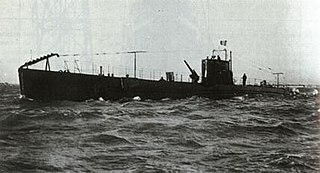
The Argonauta-class submarine was the first sub-class of the 600 Series of coastal submarines built for the Regia Marina during the 1930s. Some of these boats played a minor role in the Spanish Civil War of 1936–1939 supporting the Spanish Nationalists. Of the seven boats built in this class, only a single one survived the Second World War.
Ametista was the lead ship of her class of a dozen submarines, the second sub-class of the 600 Series of coastal submarines built for the Regia Marina during the early 1930s.
Anfitrite was one of a dozen Sirena-class submarines, the second sub-class of the 600 Series of coastal submarines built for the Regia Marina during the early 1930s.
Diamante was one of a dozen Sirena-class submarines, the second sub-class of the 600 Series of coastal submarines built for the Regia Marina during the early 1930s.
Galatea was one of a dozen Sirena-class submarines, the second sub-class of the 600 Series of coastal submarines built for the Regia Marina during the early 1930s. She played a minor role in the Spanish Civil War of 1936–1939 supporting the Spanish Nationalists.
Naiade was one of a dozen Sirena-class submarines, the second sub-class of the 600 Series of coastal submarines built for the Regia Marina during the early 1930s.
Nereide was one of a dozen Sirena-class submarines, the second sub-class of the 600 Series of coastal submarines built for the Regia Marina during the early 1930s.
Rubino was one of a dozen Sirena-class submarines, the second sub-class of the 600 Series of coastal submarines built for the Regia Marina during the early 1930s.
Sirena was one of a dozen Sirena-class submarines, the second sub-class of the 600 Series of coastal submarines built for the Regia Marina during the early 1930s.
Smeraldo was one of a dozen Sirena-class submarines, the second sub-class of the 600 Series of coastal submarines built for the Regia Marina during the early 1930s.
Topazio was one of a dozen Sirena-class submarines, the second sub-class of the 600 Series of coastal submarines built for the Regia Marina during the early 1930s. She played a minor role in the Spanish Civil War of 1936–1939 supporting the Spanish Nationalists.
Zaffiro was one of a dozen Sirena-class submarines, the second sub-class of the 600 Series of coastal submarines built for the Regia Marina during the early 1930s.
Reggio Settimo was one of two Settembrini-class submarines built for the Regia Marina during the early 1930s.
Argonauta was the lead ship of her class of seven submarines built for the Regia Marina during the early 1930s.
Fisalia was one of seven Argonauta-class submarines built for the Regia Marina during the early 1930s.
Medusa was one of seven Argonauta-class submarines built for the Regia Marina during the early 1930s.
Salpa was one of seven Argonauta-class submarines built for the Regia Marina during the early 1930s.
Pier Capponi was one of four Mameli-class submarines built for the Regia Marina during the 1920s.
Goffredo Mameli was the lead ship of her class of four submarines built for the Regia Marina during the 1920s.
Tito Speri was one of four Mameli-class submarines built for the Regia Marina during the 1920s.
